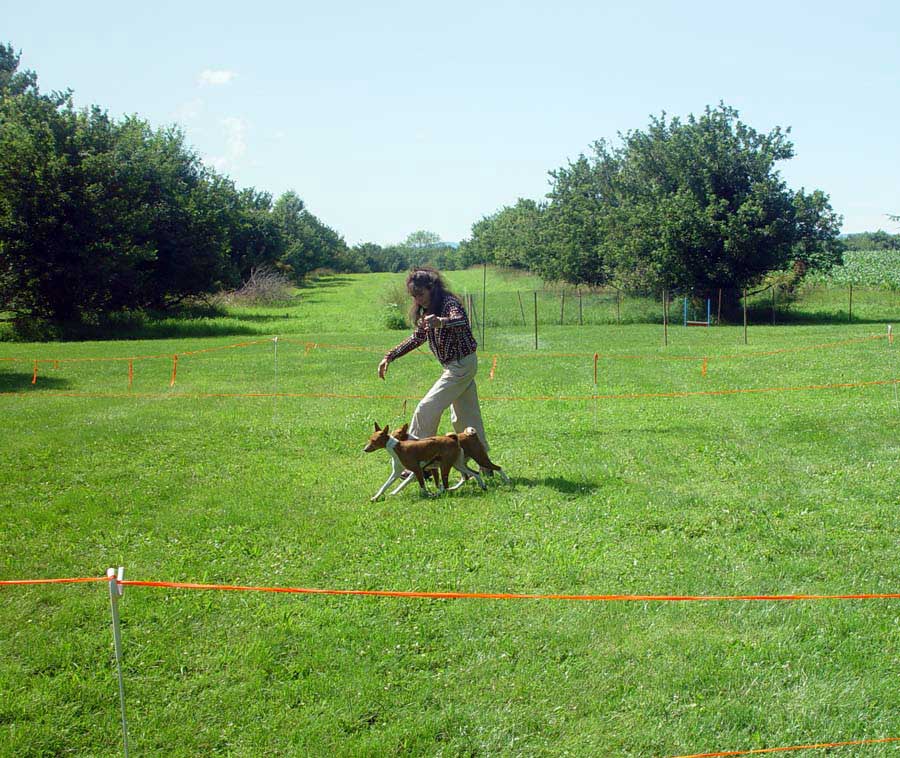The Rip Van Wrinkler, XXI, Issue 2, May 2017
Page 8 <previous page> <next page>
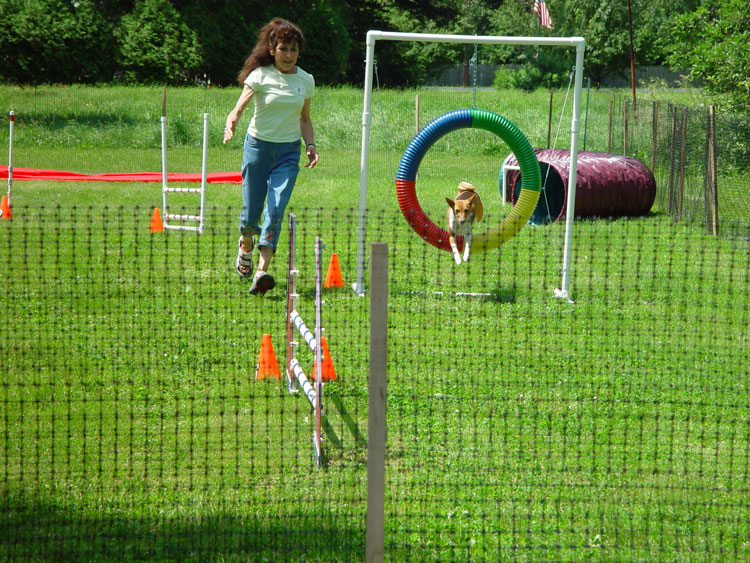
S K-M & M, long ago, at a Wrinkler Match in Red Hook, NY.
Training Conversation
Scroll down for:
New AKC titling events (Tricks, Scent).
AKC changes to Rally titling categories.
AKC accepts ASFA Cert.
AKC coming up agility pause table changes.
AKC time change for Premiere
Showing a Brace is terrific fun!
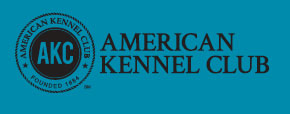
New Trick Dog Program
http://www.akc.org/trick-dog/ The New Trick Dog Program is due to officially launch May 1, 2017.
Applications can be received starting April 1st but will not be complete until after the official launch.
Any inquiries can be sent to: trickdog@akc.org or you may call 919-816-3819
FOR IMMEDIATE RELEASE
Date: March 7, 2017 Phone: 212-696-8220
THE AMERICAN KENNEL CLUB LAUNCHES NEW TRICK DOG
TITLING PROGRAM
New York, N.Y. – The American Kennel Club is pleased to announce the launch of the AKC Trick Dog program. The program will include four levels allowing dogs with any amount of experience the ability to participate. Teaching their dog tricks is enjoyable for owners, mentally stimulating for their dogs and can take place at any time or place that fits their lifestyle.
“It is easy to see why trick training is becoming so popular,” said Dr. Mary Burch, AKC Canine Good Citizen and Trick Dog Director. “The primary characteristic of trick dog training is having fun. Tricks can be both entertaining and practical, such as teaching a dog ‘paws up’ for a therapy setting. Trick dog training makes a team out of the handler and dog. We hope this exciting new program will encourage more dogs and owners to become involved in training.”
All dogs (purebred and mixed breeds), can earn Trick Dog titles provided the dog is AKC-registered, enrolled with AKC Canine Partners, or enrolled in the Purebred Alternative Listing (PAL) program. The titles will be listed on the dog’s AKC record and will appear on pedigrees.
Trick titles can be awarded by AKC approved Canine Good Citizen Evaluators, and the AKC will also recognize trick titles earned through the Do More With Your Dog (DMWYD) organization. “The AKC is proud to partner with DMWYD. Founded in 2005 by Kyra Sundance, DMWYD has introduced trick dog training to thousands of owners and their dogs,” said Doug Ljungren, Vice President of Sports and Events. “By providing basic training to our dogs, whether through CGC training, trick training or in preparation for AKC sports, we prepare our dogs to participate in more areas of our life. Together we encourage all owners to join the fun.”
To learn more about the AKC Trick Dog program and access the title application form, please visit www.akc.org/trick-dog.
The AKC will begin processing Trick Dog title applications on May 1, 2017.
-----------------------------------------------------
New AKC Scent Program
WHAT IS SCENT WORK?
AKC Scent Work is a sport that mimics the task of working detection dogs to locate a scent and communicate to the handler that the scent has been found. Real-life detection dogs are trained to search for a variety of things--drugs, explosives, human remains, currency, other contraband, living humans (such as for Search and Rescue), and much more.
AKC Scent Work takes this amazing working relationship and turns it into a fun game that any dog can play.
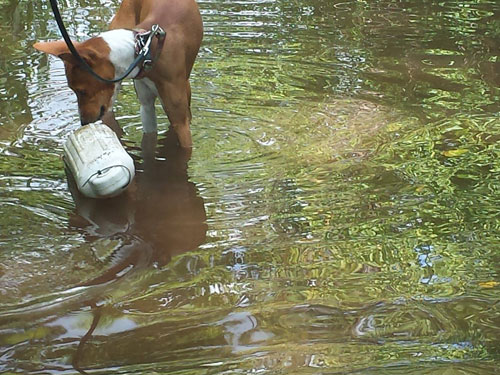 Tutu, nosework class.
Tutu, nosework class.
AM I ELIGIBLE?
To be eligible to compete in AKC Scent Work, a dog must be:
• Registered with the AKC, or
• Listed with the AKC Purebred Alternative Listing/Indefinite Listing Privilege (PAL/ILP), or
• Listed with the Canine Partners program, and
• 6 months of age or older.
HOW A SCENT WORK TRIAL WORKS
Scent Work trials, as with any AKC sport, are organized and held by AKC-Licensed or Member Clubs. The club is always your first contact regarding specific events.
The official announcement of a club's event is a called a Premium List. It contains all relevant information regarding the trial, including date, location, classes offered, and judges--as well as an entry form.
To enter an AKC Scent Work trial, the owner of the dog must submit an official AKC entry form, which can be found in the premium list. The entry form should be sent to the trial secretary that is specified in the premium. After the entries have closed, a program showing the schedule for the judging will be sent to you along with all relevant information about the trial.
AKC SCENT WORK PROGRAM
THE DIVISIONS
AKC Scent Work is broken down into two divisions. The Odor Search Division, in which the dog is searching for the odor of one or more specific essential oils, and the Handler Discrimination Division, in which the dog is searching for the scent of their handler.
THE ELEMENTS
Searches in AKC Scent Work are completed in a variety of environments, known as "Elements." The Elements in AKC Scent Work are:
• Container: The target odor is concealed within a container (such as a cardboard box or briefcase), and the dog must indicate in which container the scent is hidden.
• Interior: The target odor is concealed on or in an object in an indoor search area.
• Exterior: The target odor is concealed on or in an object in an outdoor search area--this requires the dog to locate the scent despite changing airflow patterns, weather conditions, and natural distractions.
• Buried: The target odor is concealed within a small container and then buried underneath the ground.
THE DIFFICULTY LEVELS
Each element in the Odor Search Division, and the Handler Discrimination Division, has four difficulty levels: Novice, Advaned, Excellent, and Master. Dogs will begin with the Novice level classes and move up as they earn titles, and may progress through the elements at different speeds (i.e., a dog may compete in the Novice Interior class and the Advanced Container class). Factors such as the size of the search area, the number of hides, whether the number of hides is known or unknown to the handler, and the maximum height of the hides will change with the difficulty level.
THE ODORS
The Odor Search Division of AKC Scent Work uses four odors: Birch (Betula lenta), Anise (Pimpinella anisum), Clove (Eugenia caryophyllata), and Cypress (Cupressus sempevirens). Novice searches are for Birch only, Advanced searches are for Birch and/or Anise, Excellent searches are for Birch and/or Anise and/or Clove, and Master searches are for Birch and/or Anise and/or Clove and/or Cypress.
THE DETECTIVE CLASS
The Detective Class is the highest level competition in AKC Scent Work--it offers an integrated search environment with an unknown number of hides in a variety of elements. The intent of the Detective Class is to emulate as closely as possible the work of a true detection dog. In the Detective Class, the dog is searching for one or more essential oil odors and handler scent.
THE QUALIFYING PERFORMANCE
In AKC Scent Work, handler-dog teams are judged on a qualify/non-qualify basis. The dog must use their nose to search out the hidden odors, and then alert their handlers when the odors are detected. Dogs may paw, bark, point with their nose or body, sit, lie down, or use any other behavior to communicate the location of the odor. The dog is the star of the Scent Work trial--the handler remains mostly passive, guiding the dog's search only when necessary and letting the judg eknow when the dog has found the scent.
In order to earn a qualifying leg, the handler-dog team must find and call all hides in a search area within the time allowed for the class without committing any non-qualifying faults.
Teams that qualify will then be ranked 1st through 4th, based on fewest number of faults and then on time.
For more detailed information, please see the AKC Scent Work Regulations.
HOW DO I GET STARTED IN SCENT WORK?
Scent Work is a terrific sport, because you don't necessarily have to take classes to become ready to compete at trial. And because the searches mimic real-life scenarios, training can be done at home or in the community. There are many books and videos to help you get your dog started in Scent Work.
If you need the discipline of class environment or a little more expertise, local Scent Work clubs and many dog training facilities offer training in Scent Work (or "Nosework," as it is sometimes known). See our Club Search or our Training Resources pages for more information on finding Scent Work classes near you.
-----------------------------------------------------
Enhancements to the AKC Rally® program
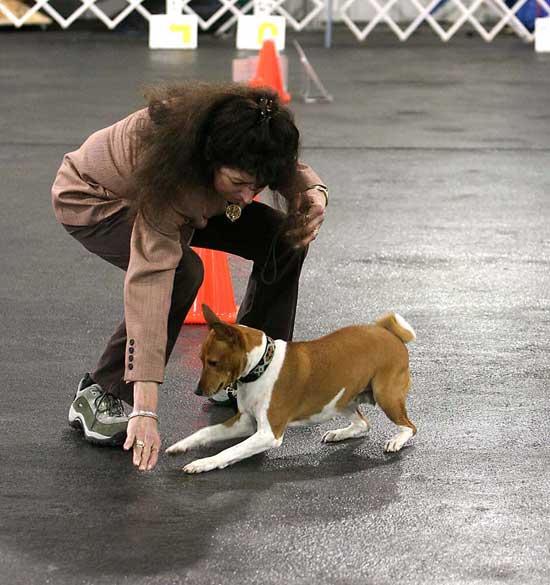 Mary Bloom photo
Mary Bloom photo
The Companion Events Department is pleased to announce new enhancements to the AKC Rally® program.
The AKC Rally program has not had any changes to the class structure since its launch in 2005. We thank you, the clubs, for your continued support in hosting AKC Rally trials.
Over the years we have heard from many rally handlers who have won the Rally Novice title, saying they are not ready to move up to the Advanced level class, which requires the dog to work off-leash. AKC has created a new class and title for dogs that have won the Rally Novice title, but have not yet earned a qualifying score in the Advanced class. The Rally Intermediate class and associated title (RI), will provide a stepping-stone class to help prepare teams for the off-leash performance required in the Advanced class. The Intermediate course is a mirror image of the Advanced course without a jump. It is the Novice exhibitor’s choice to take advantage of this additional opportunity and the RI title is not required to enter the Advanced class. We have also listened to the Rally Fancy who have long asked for a champion level title. We are excited to announce the new Master class and associated title (RM), as well as the Rally Champion title (RACH), both of which will provide additional challenges for dedicated rally exhibitors.
The criteria to earn the RACH title (sounds like “ROCK”) requires the team to earn 20 triple qualifying scores; qualifying in the Advanced B, Excellent B and Master classes at the same trial, at 20 separate events, plus earn 300 RACH points from the Excellent B and Master classes. Points are determined by a dog’s score. At least 200 RACH points must be earned from the Rally Master class.
Please review the full details of these program enhancements at this link on the AKC Rally News and Updates page and share this information with your club members responsible for managing your rally events. Clubs may start to apply for events with these new classes on August 1, 2017 for events held on or after November 1, 2017.
Should you have any questions, please write to us at Rally@akc.org.
Sincerely,
Pamela Manaton
Director of Obedience, Rally and Tracking
-----------------------------------------------------
ASFA Certification Test to Count for Open Stake
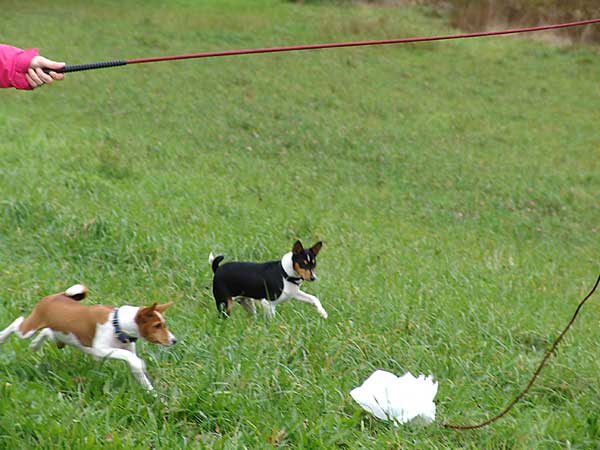
The Board VOTED to allow either the AKC Qualified Courser certificate or the American Sighthound Field Association (ASFA) Certification Course certificate to qualify a dog to be eligible to compete in an AKC lure coursing trial. Before a dog is eligible to compete in an AKC lure coursing trial it must pass an AKC Qualified Courser test to assure it is safe to run with another dog. The American Sighthound Field Association (ASFA) has an identical test called the Certification Course.
This change to Regulations is effective February 1, 2017.
-----------------------------------------------------
AKC agility changes.
Changes to the table were also approved. Effective 1-2-18.
Pause Table.
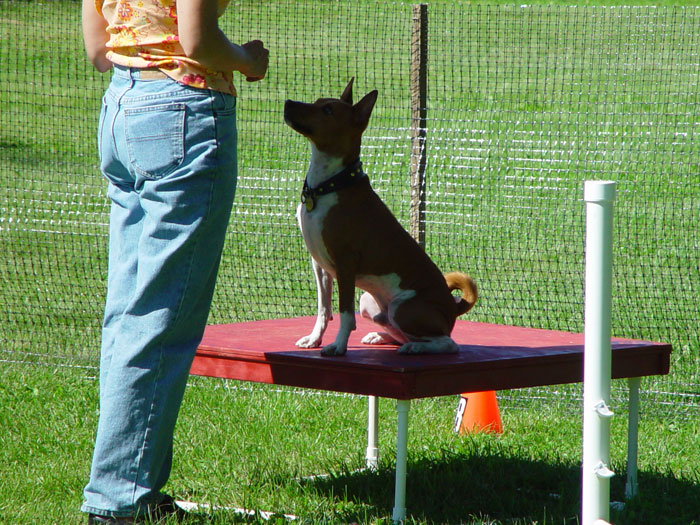 Moot and Laser.
Moot and Laser.
The top of the Pause Table is a 36-inch square, plus or minus (+/-) 2 inches, with a non-slip surface. The vertical edge of the top of the table top must be 3 inches or greater in height and it is required that the table edge and table top be of a color in contrast to the running surface and ring gating. The table top must be light in color, no dark color(s) are allowed. The height of the table (within 1 inch) is 8 inches for dogs in the 8-inch jump height; 12 inches for dogs in the 12-inch jump height; 16 inches for dogs in the 16-inch jump height; and 20 inches for dogs in the 20-inch, and 24-inch jump height.
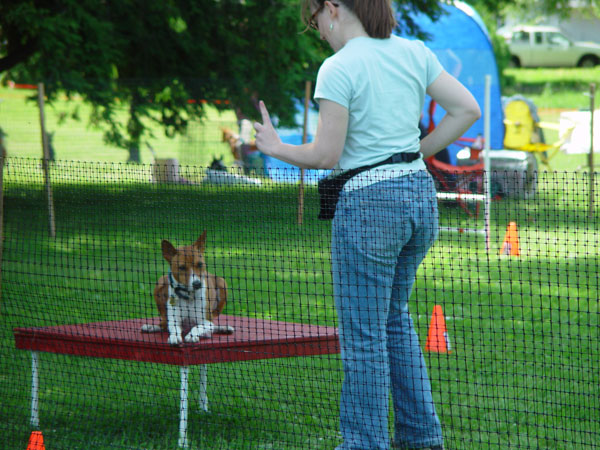 Natalie Culver and Kunjo.
Natalie Culver and Kunjo.
Preferred Class Requirement: The Pause Table shall be set at 8 inches for the 4 and 8 inch jump height, 12-inches for the dogs in the 12 inch jump height, and 16 inches for the 16 inch jump heights and 20 inches for the 20-inch division.
-----------------------------------------------------
Change to Maximun time for Permiere.
Revisions to the Regulations for Agility Trials Effective May 1, 2017
Chapter 11 Premier Section 3. Performance Standards (paragraph 3)
Maximum Course Times Premier Jumpers With Weaves Regular:
• 46 seconds for the 24 inch Regular jump height.
• 42 seconds for the 20 inch and 26 inch Regular jump heights.
• 45 seconds for the 16 inch Regular jump height.
• 48 seconds for the12 inch Regular jump height.
• 50 seconds for the 8 inch Regular jump heights.
Preferred:
• 51 seconds for the 20 inch Preferred jump height.
• 47 seconds for the16 inch Preferred jump height.
• 50 seconds for the 12 inch Preferred jump heights.
• 53 seconds for the 8 inch Preferred jump heights.
• 55 seconds for the 4 inch Preferred jump height.
Note: For timing purposes all Premier Jumpers With Weaves classes may have timer set for MCT of 55 seconds.
Showing a Brace is terrific fun!
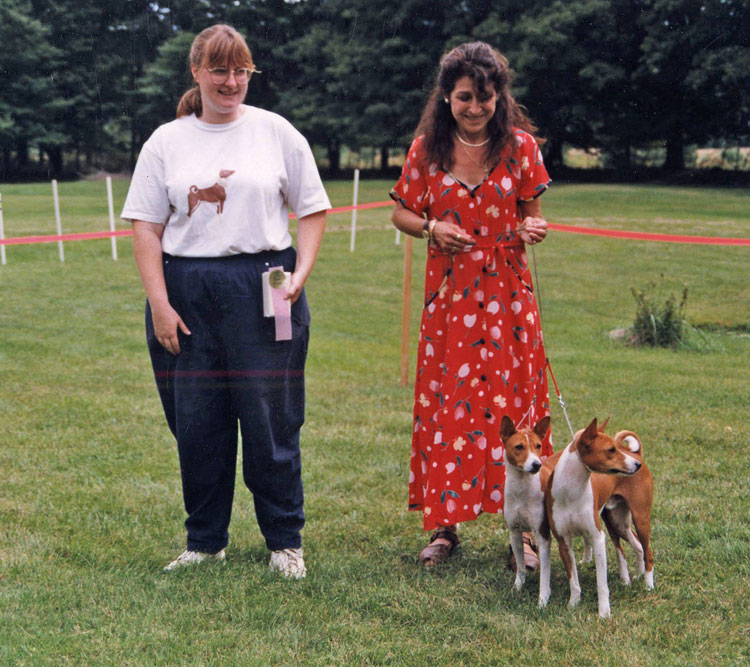
Carol Mount (judging RVW Match in 1997 or 8) & S K-M with Niner and her son, Trill.
Douglas Nielsen - "Remember when you suggested I walk Swanny and Odettte with a brace. They were gutter trained in NYC and could literally take a simultaneous dump at the curb with a fire truck speeding by and not skip a beat!!!"
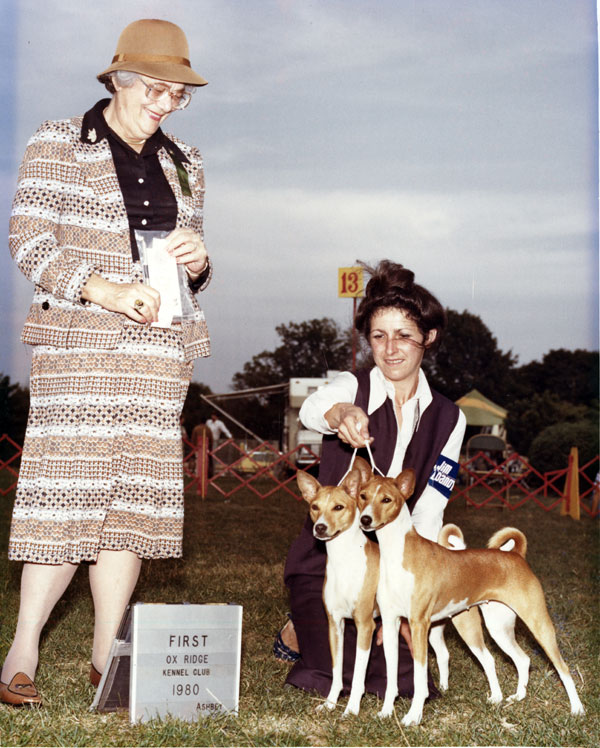
Judge Judith Felton at BCOA National Specialty, 1980. Ida & Cheat, Best Brace in Show.
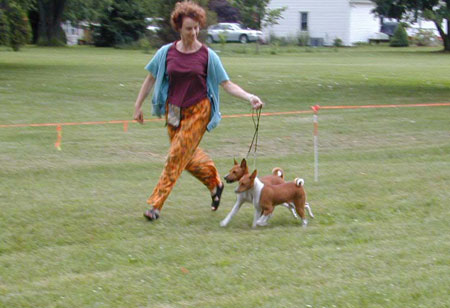
Karen Christensen with Laser and Sandy.
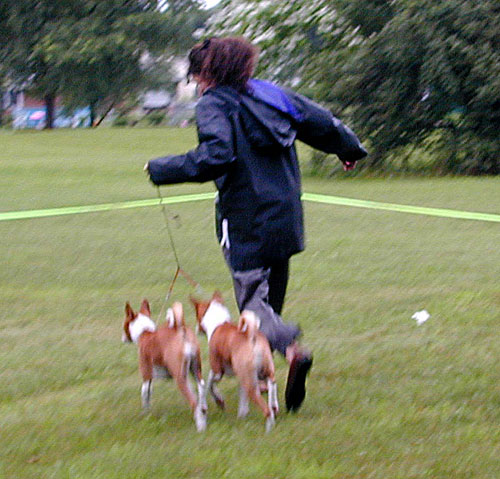
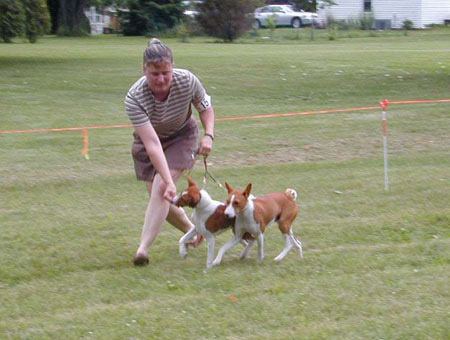
Sue Schulz with Cubby and Occhi.
